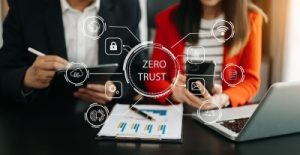
In January 2022, the Zero Trust Federal Strategy set a deadline of September 30, 2024, for agencies to adopt some level of zero trust architecture. Based on early indications, agencies have largely met zero-trust goals. The Federal CIO reported in early September that the 24 CFO Act agencies were all over 90% of the way to meeting the zero-trust goals. Beyond that group, the federal government as a whole was at 87% goal completion.
What's Changed?
The shift to zero trust is a response to the way government and citizens are using technology. With the increased use of cloud-based solutions, the traditional "castle and moat" security that protected on-premise infrastructure no longer supports the way applications are being deployed. Zero Trust focuses on continually verifying that users have permission to access the data and systems they are using. Gaining access requires coordination among a number of technologies that all work with a common set of user identification and access policies. Continue reading



 The
The  After issuing the
After issuing the  Ransomware has traditionally been a practice where cybercriminals encrypt data and demand ransom in exchange for a decryption key. More recently, a growing number of these bad actors threaten to make this information public if they do not get paid. This shift in the practice of ransomware has increased the "attractiveness" of K-12 schools for cyber criminals. Information about children is among the most highly protected data there is, making it more likely ransoms will be paid to keep it private. For this and other reasons, K-12 schools are seeing an increase in ransomware activity. In 2021, there were at least
Ransomware has traditionally been a practice where cybercriminals encrypt data and demand ransom in exchange for a decryption key. More recently, a growing number of these bad actors threaten to make this information public if they do not get paid. This shift in the practice of ransomware has increased the "attractiveness" of K-12 schools for cyber criminals. Information about children is among the most highly protected data there is, making it more likely ransoms will be paid to keep it private. For this and other reasons, K-12 schools are seeing an increase in ransomware activity. In 2021, there were at least  With so many high-profile hacks this year, it's easy to want to throw up your hands and say, "Is there nothing that can be trusted?!" Interestingly, that lament is what is driving the latest approach to cybersecurity -- zero trust. Zero trust is what it sounds like, a security approach
With so many high-profile hacks this year, it's easy to want to throw up your hands and say, "Is there nothing that can be trusted?!" Interestingly, that lament is what is driving the latest approach to cybersecurity -- zero trust. Zero trust is what it sounds like, a security approach 
